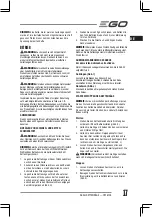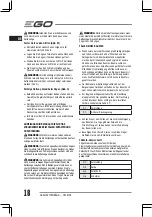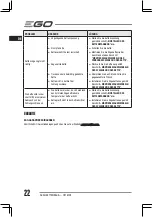
CORDLESS CHAIN SAW — CS1610E
10
EN
◾
An escape path should be planned and cleared as
necessary before cuts are started. The escape path
should extend back and diagonally to the rear of the
expected line of fall as Fig. P shown.
P-1
Felling Direction
P-2
Safety Retreat Path
◾
Before felling is started, consider the natural lean of
the tree, the location of larger branches and the wind
direction to judge which way the tree will fall.
◾
Remove dirt, stones, loose bark, nails, staples and wire
from the tree.
Notching undercut
Make the notch 1/3 the diameter of the tree, perpendicular
to the direction of falls as Fig. Q shown. Make the lower
horizontal notching cut first. This will help to avoid pinching
either the saw chain or the guide bar when the second notch
is being made.
Q-1
Direction of fall
Q-2
Notch
Q-3
Felling back cut
Q-4
Hinge
Felling back cut
◾
Make the felling back cut at least 50 mm higher than
the horizontal notching cut as Fig. Q shown. Keep the
felling back cut parallel to the horizontal notching cut.
Make the felling back cut so enough wood is left to
act as a hinge. The hinge wood keeps the tree from
twisting and falling in the wrong direction. Do not cut
through the hinge.
◾
As the felling gets close to the hinge, the tree should
begin to fall. If there is any chance that the tree may
not fall in desired direction or it may rock back and
bind the saw chain, stop cutting before the felling back
cut is complete and use wedges of wood, plastic or
aluminium to open the cut and drop the tree along the
desired line of fall.
◾
When the tree begins to fall remove the chain saw
from the cut, stop the motor, put the chain saw
down, then use the retreat path planned. Be alert for
overhead limbs falling and watch your footing.
Limbing a tree
Limbing is removing the branches from a fallen tree. When
limbing leave larger lower limbs to support the log off the
ground. Remove the small limbs in one cut as Fig. R shown.
Branches under tension should be cut from the bottom up to
avoid binding the chain saw.
Bucking a log
◾
Bucking is cutting a log into lengths. It is important
to make sure your footing is firm and your weight is
evenly distributed on both feet. When possible, the log
should be raised and supported by the use of limbs,
logs or chocks. Follow the simple directions for easy
cutting.
◾
When the log is supported along its entire length as
Fig. S1 shown, it is cut from the top (overbuck).
◾
When the log is supported on one end, as Fig. S2
shown, cut 1/3 the diameter from the underside
(underbuck). Then make the finished cut by
overbucking to meet the first cut.
◾
When the log is supported on both ends, as Fig. S3
shown, cut 1/3 the diameter from the top (overbuck).
Then make the finished cut by underbucking the lower
2/3 to meet the first cut.
◾
When bucking on a slope always stand on the uphill
side of the log, as Fig. T shown.
◾
When “cutting through”, to maintain complete control
release the cutting pressure near the end of the cut
without relaxing your grip on the chain saw handles.
Don’t let the chain contact the ground. After completing
the cut, wait for the saw chain to stop before you move
the chain saw. Always stop the motor before moving
from tree to tree.
MAINTENANCE
WARNING:
When servicing, use only identical
replacement parts. Use of any other parts may create a
hazard or cause product damage.
WARNING:
To avoid serious personal injury, remove the
battery pack from the chain saw before inspecting, cleaning,
or performing maintenance. A battery operated tool with the
battery pack inserted is always on and can start accidently.
WARNING:
When cleaning the chain saw, DO NOT
immerse in water or other liquids.
WARNING:
Do not at any time let brake fluids, petrol,
petroleum-based products, penetrating oils, etc., come in
contact with plastic parts. Chemicals can damage, weaken, or
destroy plastic, which may result in serious personal injury.
CLEANING
◾
After each use, clean debris from the chain and guide
bar with a soft brush. Wipe the chain saw surface with
a clean cloth moistened with a mild soap solution.
Summary of Contents for CS1610E
Page 3: ...D D 1 D 2 E1 C E2 F H I G 1 3mm E 4 E 3 E 2 E 1...
Page 4: ...Q Q 1 Q 2 Q 3 Q 4 45 P P 1 J L K M N O P 2 P 2...
Page 5: ...R S1 S2 T S3 1 1 2 2 U1 U2 U2 1 U2 2 U3...
Page 102: ...102 RU CS1610E AG1600 AG1601 XX...
Page 104: ...104 RU CS1610E 10 11 12 13 14 15 1 B 2 3 C 4 D 5 6 E1 E2 7 8 F 9 D 1 E 2 D 2 E 3 E 1 E 4 1 3 G...
Page 105: ...105 RU CS1610E 1 2 3 H 4 MAX 5 A2 I J 1 K 2 3 L 4 1 2 K M...
Page 106: ...106 RU CS1610E N O P P 1 P 2 1 3 Q Q 1 Q 2 Q 3 Q 4 50 Q...
Page 107: ...107 RU CS1610E R S1 S2 1 3 S3 1 3 2 3 T U1 U2 U3 U2 1 U2 2...
Page 108: ...108 RU CS1610E WEEE...
Page 109: ...109 RU CS1610E 67 C 67 C EGO...
Page 110: ...110 RU CS1610E EGO egopowerplus com EGO...
Page 177: ...177 GR CS1610E AG1600 AG1601 XX...
Page 180: ...180 GR CS1610E 1 2 3 H 4 MAX 5 2 I J 1 K 2 3 L 4...
Page 181: ...181 GR CS1610E 1 2 K M N O P P 1 P 2 1 3 Q Q 1 Q 2...
Page 182: ...182 GR CS1610E Q 3 Q 4 50 mm Q R S1 S2 1 3 S3 1 3 2 3 T...
Page 183: ...183 GR CS1610E U1 U2 U3 U2 1 U2 2...
Page 184: ...184 GR CS1610E 67 C 67 C EGO...
Page 185: ...185 GR CS1610E EGO egopowerplus com EGO...
Page 202: ...202 UK CS1610E AG1600 AG1601 XX WEEE...
Page 204: ...204 UK CS1610E 1 B 2 3 C 4 D 5 6 E1 E2 7 8 F 9 D 1 E 2 D 2 E 3 E 1 E 4 1 3 G...
Page 205: ...205 UK CS1610E 1 2 3 H 4 MAX 5 A2 I J 1 K 2 3 L 4 1 2 K M N O...
Page 206: ...206 UK CS1610E P P 1 P 2 1 3 Q Q 1 Q 2 Q 3 Q 4 50 Q R...
Page 207: ...207 UK CS1610E S1 S2 1 3 S3 1 3 2 3 T U1 U2 U3 U2 1 U2 2...
Page 208: ...208 UK CS1610E WEEE...
Page 209: ...209 UK CS1610E 67 C 67 C EGO...
Page 210: ...210 UK CS1610E EGO egopowerplus com EGO edin...
Page 211: ...211 BG CS1610E AG1600 AG1601 XX WEEE...
Page 213: ...213 BG CS1610E 14 15 1 2 3 4 D 5 6 E1 E2 7 8 F 9 D 1 E 2 D 2 E 3 E 1 E 4 1 3 G...
Page 214: ...214 BG CS1610E 1 2 3 H 4 MAX 5 2 I J 1 K 2 3 L 4 1...
Page 215: ...215 BG CS1610E 2 K M N O P P 1 P 2 1 3 Q Q 1 Q 2 Q 3 Q 4...
Page 216: ...216 BG CS1610E 50 mm Q R S1 S2 1 3 S3 1 3 2 3 T...
Page 217: ...217 BG CS1610E U1 U2 U3 U2 1 U2 2 WEEE...
Page 218: ...218 BG CS1610E 67 C 67 C EGO...
Page 219: ...219 BG CS1610E EGO egopowerplus com EGO...
Page 228: ...CS1610E 228 KA AG1600 AG1601 XX...
Page 231: ...CS1610E 231 KA 1 3 G 1 2 3 H 4 5...
Page 232: ...CS1610E 232 KA A2 I I J J 1 K 2 3 L 4 1 2 K M M N O O...
Page 233: ...CS1610E 233 KA P P 1 P 2 1 3 Q Q 1 Q 2 Q 3 Q 4 50 Q R...
Page 234: ...CS1610E 234 KA S1 S2 1 3 S3 1 3 2 3 T U1...
Page 235: ...CS1610E 235 KA U2 U3 U2 1 U2 2 WEEE...
Page 236: ...CS1610E 236 KA 67 C 67 C EGO...
Page 237: ...CS1610E 237 KA EGO EGO egopowerplus com egopowerplus com EGO...
Page 254: ...56 CS1610E 254 HE XX AG1600 AG1601 WEEE...
Page 256: ...56 CS1610E 256 HE 6 E1 E2 7 8 F 9 E 2 D 1 E 3 D 2 E 4 E 1 1 3 G 1 2 3 H 4 5...
Page 257: ...56 CS1610E 257 HE A2 I J 1 K 2 3 L 4 1 2 K M N O P...
Page 258: ...56 CS1610E 258 HE P 1 P 2 3 1 Q Q 1 Q 2 Q 3 Q 4 50 Q R S1 1 3 S2 1 3 S3 2 3 T...
Page 259: ...56 CS1610E 259 HE U1 U2 U3 U2 1 U2 2 WEEE...
Page 260: ...56 CS1610E 260 HE 67 C 67 C EGO...
Page 261: ...56 CS1610E 261 HE EGO EGO egopowerplus com...
Page 262: ...262 56 CS1610E AR XX AG1600 AG1601 EEEW EC...
Page 264: ...264 56 CS1610E AR E2 7 8 F 9 E 2 D 1 E 3 D 2 E 4 E 1 G 1 3 1 2 3 H 4 MAX 5 A2 I I J J...
Page 265: ...265 56 CS1610E AR 1 K 2 3 L 4 1 2 K M M N O O P P 1 P 2 3 1 Q Q 1 Q 2 Q 3 Q 4 Q 05...
Page 266: ...266 56 CS1610E AR R 1S 3 1 2S 3 1 3S T U1 U2 U3 U2 1 U2 2...
Page 267: ...267 56 CS1610E AR WEEE...
Page 268: ...268 56 CS1610E AR 67 67 EGO...











































